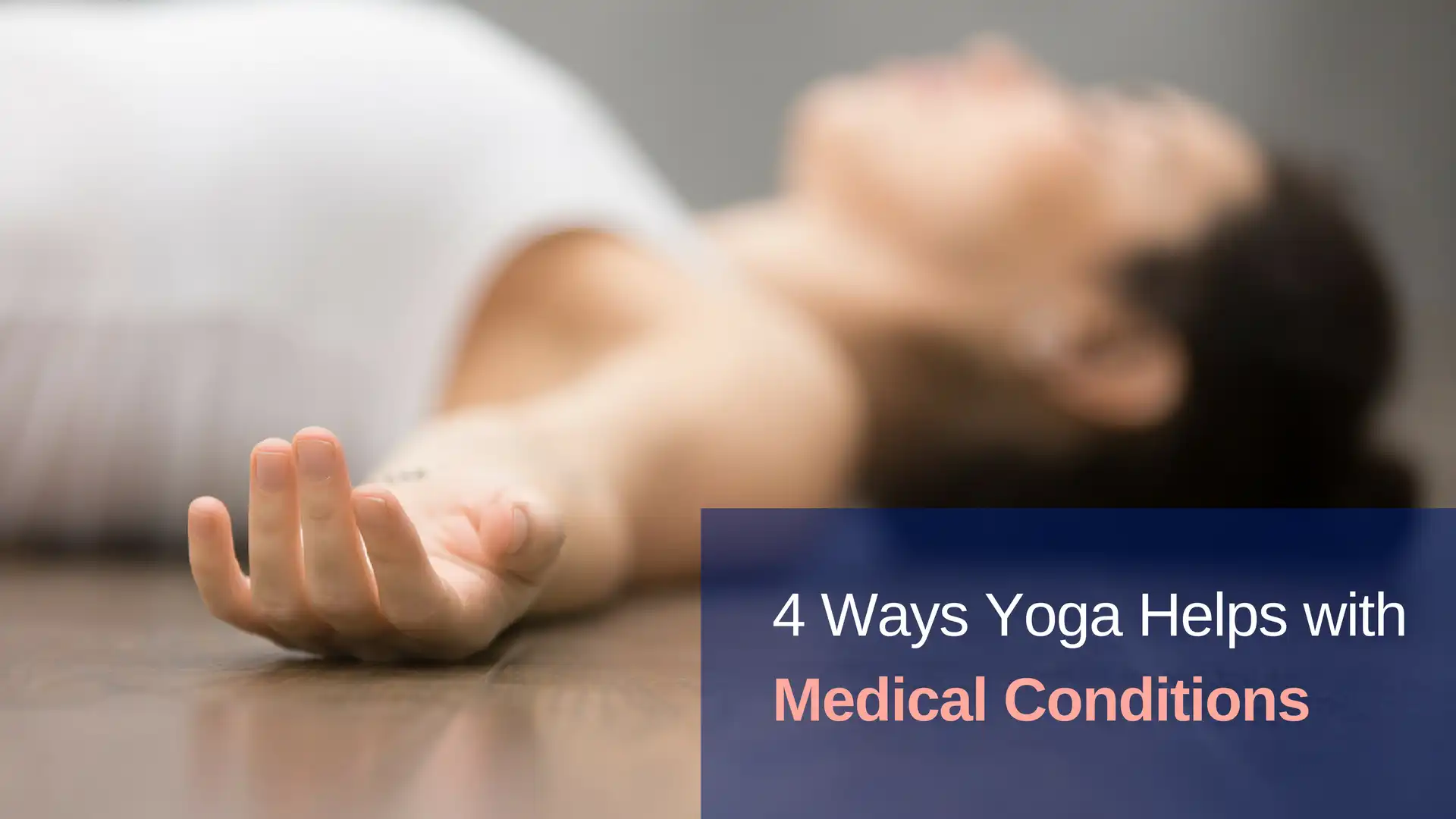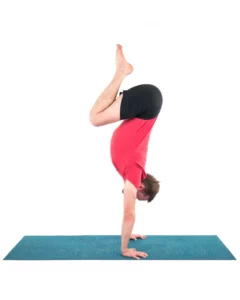4 Ways Yoga Helps with Medical Conditions: Adjunct to Western Medicine

In our posts How Yoga Helps with Medical Conditions: Prevention and How Yoga Helps Medical Conditions: Symptom Improvement, we described yoga’s powerful role in preventing medical conditions, and for improving symptoms and sometimes even curing conditions. Today, we will look at an equally valuable application of yoga: as an adjunct to Western healing modalities.
For yoga, acting as adjunct treatment means playing a secondary role by supporting or enhancing the effects of the primary forms of treatment. I personally experienced this when I was being treated for a frozen shoulder. The Western medical treatment included a steroid injection and physical therapy, and I supplemented that treatment by practicing asanas to improve flexibility and using breath work for pain management.
There are four basic ways you can use yoga as an adjunct to western medical treatment.
1. Yoga as Adjunct for Prevention
When you are using Western medical recommendations to prevent a medical condition, you can use yoga to support your efforts. For example, if you have a family history of diabetes and want to do everything you can to prevent yourself from developing the disease, you could use yoga stress management techniques and active asana practices to support the primary preventive recommendations your doctor provided, such as making dietary changes, maintaining a healthy weight, and maintaining adequate levels of exercise. Other examples include using yoga as an adjunct for prevention of heart disease, high blood pressure and obesity.
2. Yoga as Adjunct for Ongoing Treatment
When you are receiving ongoing medical treatment for a condition or disease, such as multiple sclerosis, chronic back pain, or high blood pressure, you can use yoga to improve symptoms, such as pain or weakness, to prevent your condition from worsening, or to help you maintain your present level of functioning. You can also use yoga’s stress management techniques to help you deal with stress of having an ongoing medical problem.
3. Yoga as Adjunct for Rehabilitation
When you are undergoing rehabilitation from physical problems, including an injury, recent surgery, cancer treatment, stroke or heart attack, you can use yoga as an adjunct to the primary treatments, such as medication or physical therapy, which you are receiving to help you heal. For example, after cancer treatment you could use your asana practice to regain strength and stress management tools to help you recover emotionally. And for emotional problems, such as anxiety and depression, you could supplement medication and talk therapy with yoga stress management and equanimity practices.
4. Yoga as Adjunct for Palliative Care
When you have a condition for which there is no cure, you can use yoga for symptom relief and comfort care as a supplement to medications and other primary treatments. For example, for someone with COPD (emphysema), who will not regain normal breathing even with Western medications, yoga tools such as meditation and simple breathing practices can help ease anxiety and stabilize symptoms, at least for a while. For end-of-life care, yoga can complement hospice care, helping to ease the transition towards death.
Study with Baxter Bell, MD and YogaUOnline – Yoga for Your Brain: A New Formula for Healthy Aging.
Also, read...
Desk-Friendly Yoga Neck and Shoulder Stretches
Dec 01 – Kathryn Boland, R-CYT, R-DMT
6 Yoga Poses to Expand Your Heart
Nov 24 – Charlotte Bell
Yoga Practice Tips: Why Listening to Your Body Might Not Be Enough
Nov 20 – Charlotte Bell
Related courses
Reprinted with permission from Yoga for Healthy Aging.

Baxter Bell, MD, C-IAYT, YACEP, fell in love with yoga in 1993 while he was working full-time as a family physician. His appreciation for the potential of yoga to foster health, healing, and equanimity was so great that he soon stepped down from his medical practice and trained to become a yoga teacher. Now, he focuses on teaching yoga full time, both to ordinary students of all ages and physical conditions and to the next generation of yoga teachers and yoga therapists, to whom he teaches anatomy and yoga therapy along with his accessible, skillful style of yoga. He also sees students privately, helping them use yoga to help heal from and/or cope with a wide range of medical conditions. At this point, with 23+ years of teaching experience under his belt, Baxter brings a unique perspective to his teaching, combining his understanding of anatomy and medicine with his skill at instructing people from all walks of life and all levels of ability.
In addition to teaching classes, workshops, and retreats internationally, Baxter is a past presenter at Yoga Journal Conferences and the International Association of Yoga Therapy’s Sytar Conference and teaches online courses and classes at Yoga U Online. Baxter is also the co-author of the popular and ground-breaking book Yoga for Healthy Aging and his blog, “What’s On Your (Yoga) Mind,” where he shares his knowledge of medical conditions, anatomy, yoga, and more with practitioners and teachers across the world. He has written articles for the Yoga Journal and the Journal of the International Association of Yoga Therapy. He is often quoted as an expert on yoga and health by major national news outlets such as the Washington Post and the Wall Street Journal. To learn more, visit www.baxterbell.com, and his YouTube channel and Instagram page at Baxter Bell Yoga.
Recent articles
Desk-Friendly Yoga Neck and Shoulder Stretches
Dec 01 – Kathryn Boland, R-CYT, R-DMT
6 Yoga Poses to Expand Your Heart
Nov 24 – Charlotte Bell
Discovering the Living Body: A Yoga Teacher’s Revolutionary Insight on Fascia
Nov 22 – Eva Norlyk Smith, Ph.D.
Categories
Upcoming courses
Recent articles
Almost there...
Sorry, we couldn't find anything...
Yoga Practice Tips
Desk-Friendly Yoga Neck and Shoulder Stretches
If you’re reading this, you’re a human living in 2022. If you’re a human…
Dec 01 – Kathryn Boland, R-CYT, R-DMT
Yoga Practice Tips
6 Yoga Poses to Expand Your Heart
Have you ever been in a yoga class when someone (maybe you) experienced a…
Nov 24 – Charlotte Bell
Anatomy
Discovering the Living Body: A Yoga Teacher’s Revolutionary Insight on Fascia
What if everything you thought you knew about your body was too static? In…
Nov 22 – Eva Norlyk Smith, Ph.D.



